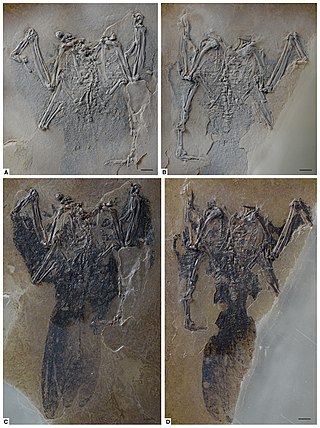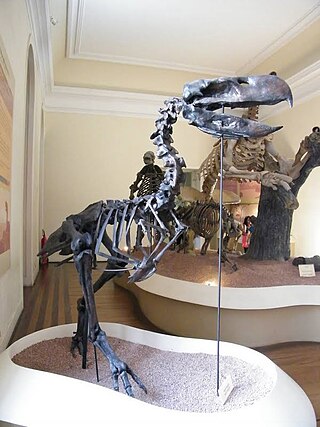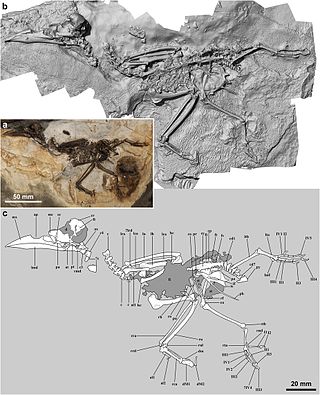
The Coraciiformes are a group of usually colourful birds including the kingfishers, the bee-eaters, the rollers, the motmots, and the todies. They generally have syndactyly, with three forward-pointing toes, though in many kingfishers one of these is missing. The members of this order are linked by their "slamming" behaviour, thrashing their prey onto surfaces to disarm or incapacitate them.

The Apodiformes is an order, or taxonomic grouping, of birds which traditionally contained three living families—the Apodidae (swifts), the Hemiprocnidae (treeswifts), and the Trochilidae (hummingbirds); however, in the Sibley-Ahlquist taxonomy, this order is elevated to the superorder Apodimorphae, in which hummingbirds are separated into a new order, the Trochiliformes. With nearly 450 species identified to date, it is the most diverse order of birds after the Passeriformes.

Owlet-nightjars are small crepuscular birds related to the nightjars and frogmouths. Most are native to New Guinea, but some species extend to Australia, the Moluccas, and New Caledonia. A flightless species from New Zealand is extinct. There is a single monotypic family Aegothelidae with the genus Aegotheles.

Brontornis is an extinct genus of giant bird that inhabited Argentina during the Early to Middle Miocene. Its taxonomic position is highly controversial, with authors alternatively considering it to be a cariamiform, typically a phorusrhacid or an anserimorph.

Archaeotrogonidae is a prehistoric bird family known from the Eocene and Oligocene of Europe. They are members of Strisores, and are thought to be closely related to nightjars.

Paraphysornis is an extinct genus of giant flightless terror birds that inhabited Brazil during Late Oligocene or Early Miocene epochs. Although not the tallest phorusrhacid, Paraphysornis measured up to 1.4 metres tall at the hips and weighed around 180–240 kilograms (400–530 lb). It was also a notably robust bird, having short and robust tarsal bones not suited for pursuit hunting.

Neoaves is a clade that consists of all modern birds with the exception of Palaeognathae and Galloanserae. This group is defined in the PhyloCode by George Sangster and colleagues in 2022 as "the most inclusive crown clade containing Passer domesticus, but not Gallus gallus". Almost 95% of the roughly 10,000 known species of extant birds belong to the Neoaves.

Patagornis is a genus of extinct flightless predatory birds of the family Phorusrhacidae. Known as "terror birds", these lived in what is now Argentina during the Early and Middle Miocene; the Santa Cruz Formation in Patagonia contains numerous specimens. Patagornis was an agile, medium sized Patagornithine and was likely a pursuit predator.

Odontopteryx is a genus of the extinct pseudotooth birds or pelagornithids. These were probably rather close relatives of either pelicans and storks, or of waterfowl, and are here placed in the order Odontopterygiformes to account for this uncertainty.
Eurofluvioviridavis is a genus of extinct birds from the Middle Eocene Messel Pit, Germany. It contains a single species, Eurofluvioviridavis robustipes. It is related to Avolatavis and Vastanavis, other members of the family Vastanavidae.

Strisores, sometimes called nightbirds, is a clade of birds that includes the living families and orders Caprimulgidae, Nyctibiidae (potoos), Steatornithidae (oilbirds), Podargidae (frogmouths), Apodiformes, as well as the Aegotheliformes (owlet-nightjars) whose distinctness was only recently realized. The Apodiformes and the Aegotheliformes form the Daedalornithes.

Septencoracias is an extinct genus of bird related to modern rollers and other Coraciiformes such as kingfishers, bee-eaters, motmots, and todies. It contains two species, Septencoracias morsensis described in 2016, and S. simillimus, which was named in 2024. It was found in the Fur Formation of Denmark, dating back to the Ypresian of the Lower Eocene Epoch, about 54 million years ago. Septencoracias is one of the earliest known members of Coraciiformes, lending insight into the earliest radiation of this group.
The Laguna del Hunco Formation or Laguna del Hunco Tuff is a localized Early Eocene fossiliferous geological formation of the Cañadón Asfalto Basin in central Patagonia, Argentina. The 170 metres (560 ft) thick formation comprises tuffaceous mudstones and sandstones deposited in a crater lake environment and crops out at Laguna del Hunco in the northwestern Chubut Province.

The Huitrera Formation is a geological formation in the Neuquén Basin in northern Patagonian Argentina whose strata date back to the Early Eocene of the Paleogene, or Casamayoran in the South American land mammal age classification.

Eocoracias is an extinct genus of bird related to modern rollers and other Coraciiformes such as kingfishers, bee-eaters, motmots, and todies. It contains one species, Eocoracias brachyptera, and it lived approximately 47 million years ago based on dating of the fossil site. It is known for a specimen having preserved non-iridescent structural coloration on its feathers, previously unknown in fossil birds. Fossils have been found at the Messel Pit in Germany.

Vanescaves is a probable clade of strisorean birds that include the clades Steatornithiformes, Nyctibiiformes, Podargiformes (frogmouths), and Apodimorphae. Some molecular studies do support the grouping of these birds, others offer conflicting positions of the non-apodimorphaean strisoreans. In 2019 the authors Chen et al. performed a combined analysis using 2289 ultra-conserved elements [UCEs], 117 morphological characters from extant and fossil taxa found support in this clade. The authors then proposed to name this group, which its meaning is Latin for "vanish birds" in reference to the disparate nature of their geographic distribution, as well as to the poem "A Route of Evanescence" by the American poet Emily Dickinson which features a hummingbird as the main subject. In 2020 Chen & Field named the two major subclades of this group, with Sedentaves and Letornithes for their crown-groups.

Tonsala is an extinct genus of Plotopteridae, a family of flightless seabird similar in biology with penguins, but more closely related to modern cormorants. The genus is known from terrains dated from the Late Oligocene of the State of Washington and Japan.

Phocavis is an extinct genus of flightless seabird, belonging to the family Plotopteridae, and distantly related with modern cormorants. Its fossils, found in the Keasey Formation in Oregon, are dated from the Late Eocene.

Ypresiglaux is an extinct genus of strigiform bird from the Early Eocene London Clay Formation of Essex, United Kingdom and Nanjemoy Formation of Virginia, United States. The genus contains two species: Y. michaeldanielsi, known from a partial skeleton, and Y. gulottai, known from a distal tarsometatarsus.
Pseudasturides is an extinct genus of halcyornithid bird from the Middle Eocene Messel pit in Hesse, Germany, and possibly the Isle of Sheppey, United Kingdom. The genus is represented by a single species, Pseudasturides macrocephalus.

















